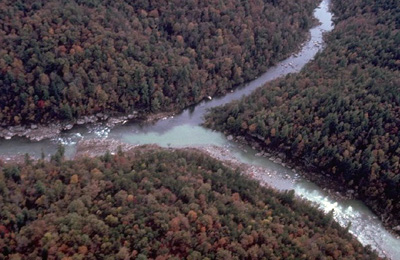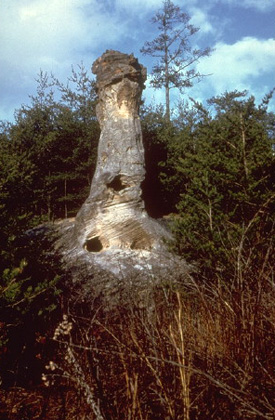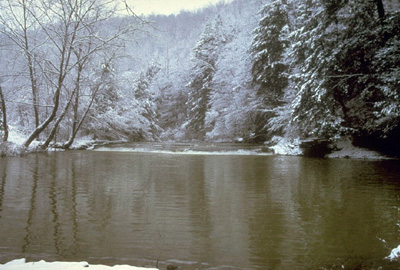
Park resources manager loves wilderness
While earning his master’s degree at Virginia Tech in Blacksburg, Va., Tom Blount, 46, did not know what he would pursue with his degree. After teaching at Glenville State College, where he specialized in land resource management, Blount realized he wanted more. Little did he know his future would be in managing resources for Big South Fork National River and Recreation Area in Oneida, Tenn.
“My position in the park service wasn’t what I thought I’d end up doing,” said Blount, who is chief resource manager at Big South Fork and has held the position for the past six years.
 |
Two rivers converge to form the Big South Fork River in the Big South Fork National River and Recreation Area (Photo courtesy of the National Park Service). |
Blount’s concentration in graduate school centered on forest regeneration, which focuses on monitoring the animal and plant life of a plot area and seeing how the natural resources reproduce with the affects of human interaction.
After receiving his master’s in forest biology, he wanted to apply his education and research.
“To get my foot in the door, I had to get a degree in natural cultural resources, and work my way up. To get to the professional level within the National Park Service, as opposed to being a seasonal worker, you must get a graduate degree in biological resources,” Blount said about starting a career in the National Park Service.
Kick-starting his career at Shenandoah National Park in Virginia as the assistant division chief, Blount ended up staying there for 12 years. He supervised a program overseeing the land management. At Shenandoah, Blount was responsible for monitoring how visitors affected the natural ecosystems within the park.
“Since we allowed fishing in the park, we saw the affects of fishermen using the natural conditions and made sure they weren’t threatening the fish and their habitat. We controlled the fishing and monitored the contaminants in the water,” said Blount.
This raises awareness to visitors about the affects they have on the delicate environment and ecosystems that exist in federal parks and recreation areas such as Shenandoah National Park. This is the kind of work Blount and his team creates for balance between animal and man.
“We see if our resources are sustainable to account for the fishermen,” said Blount about the checks on humans in a national park such as Shenandoah.
“We do the same kind of monitoring of species within the park such as with the gypsy moth. The moth is threatened when non-native plants are introduced to this exotic species. This has to be controlled so the natural world is protected,” Blount said about the importance of collecting data and monitoring the land vegetation.
| Scenery, such as this old tree trunk, can be surprising in the Big South Fork National River and Recreation Area (Photo courtesy of the National Park Service). |
 |
“I was in charge during the summer season, which lasted from May to August, and hired biological technicians and an entire crew of workers including a botanist and archeologists as well as other specialists to go out into the field and collect data in the environment. They do this work during the summer season because this is when the plants are growing,” Blount said about supervising his group of workers.
At Shenandoah, Blount oversaw a team of workers for a program that was the first of its kind. It was a testing program initially developed to collect data in making decisions for environmental health for the national parks. The research that was accomplished at Shenandoah contributed to a nationwide model for the National Parks System.
Blount’s current position at Big South Fork National River and Recreation Area, deals with many of the same issues with his position as chief resource manager, but in a smaller, more rural setting then Shenandoah.
Blount is stationed in the Tennessee headquarters office of Big South Fork with a team including a biologist, botanist, archeologists, oil and gas tech, and a collections management person who deals with the historical aspects of the park and knowledge of the natural resources that thrive in Big South Fork.
“Since we are a downstream park, we work closely with state agencies to monitor the water quality. Since my division deals with resource issues, I also advise superintendents. A part of managing the park at Big South Fork involves administrative issues as well. I have made a transition to where the specialists are doing work in the field and I’m at a desk,” said Blount about his changing roles.
Blount also is never surprise by the capabilities of the wildlife within the park.
“A bear stuck his head into a water valve and couldn’t get out. It eventually cut off his oxygen and it died,” said Blount about the curiosity of wildlife and the changes humans make to their habitat.
“I have a passion for the national parks because it’s personally satisfying to me. I fully support the mission of the national parks to protect the natural diversity and endangered species,” said Blount about his NPS role today.
“I always knew that I didn’t want to work in a big populated area. I wanted to be in a rural area. I like the outdoors and activities associated with it. I go to work and pass five cars everyday, this is what I value the most,” said Blount about the isolated, quiet aspect of Big South Fork.
 |
Winter provides amazing scenery in the Big South Fork National River and Recreation Area (Photo courtesy of the National Park Service). |
“The purpose of my job at Big South Fork has to do with land management. There is a balance that has to be created with the budget and the demands of the park. With the 700,000 visitors we get to our park each year, visitors are a double-edged sword,” said Blount.
“We want visitors to come and support Big South Fork, but this creates more challenges that have to be adequately addressed by the park. Sometimes it is too much of a good thing,” said Blount about keeping up with its attendees.
“My favorite part about the park and why were under the radar is because of the park’s natural ruggedness. It has a steep landscape and a river that carves a canyon with magnificent rock formations and arches. It’s fabulous,” said Blount about the attraction of Big South Fork.
Big South Fork is backcountry at its best with its serene remoteness; it has kept Blount there and close to his family. It’s pure simplicity where on the weekends he can paddle a canoe down the river or ride a horse on one of the area’s many trails.
“I’ll be here until I retire, unless I’m offered more money to do something more fun than this,” said Blount.

Comments are Closed